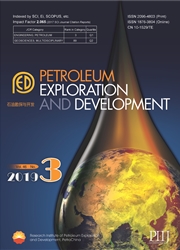Architecture of deepwater turbidite lobes: A case study of Carboniferous turbidite outcrop in the Clare Basin, Ireland
作者:ZHANG Leifu,LI Yilong
摘要:Through lithofacies analysis and architecture anatomy of the Carboniferous Ross Sandstone turbidites outcropped at western Ireland,the depositional model of deepwater turbidite lobes is established.Seven types of lithofacies are recognized including goniatites-rich shale,laminated shale,laminated siltstone,massive sandstone,fine-medium sandstone with mud-clast,basal gravel,and chaotic mudstone,which can be subdivided into units of three origins,turbidite lobe,turbidite channel,and slide-slump;and four hierarchical levels,lobe complex,lobe,lobe element and single sandstone layer.The lobes show apparent compensational stacking pattern,lobe elements display typical thickening-upward cycles on vertical profile,and the higher the hierarchical level,the better the preservation of the hierarchical boundary is.In general,turbidite lobe deposits appear as tabular,parallel/sub-parallel sandstone and mudstone interbeds,and change from thick,massive sandstone in the proximal end to thinner sandstone and mudstone interbeds from axis to fringe,with the sand-shale ratio and degree of sandstone amalgamation decreasing.
发文机构:National Energy Shale Gas Research(Experiment)Center PetroChina Research Institute of Petroleum Exploration&Development CNPC Key Lab of Unconventional Oil and Gas
关键词:deepwatersedimentationturbiditelobesoutcropanatomyarchitecturehierarchyquantitativecharacterizationCarboniferousRossSandstoneFormationIRELAND
分类号: P618.13[天文地球—矿床学]
- Enrichment and exploration of deep lacustrine shale oil in the first member of Cretaceous Qingshankou Formation, southern Songliao Basin, NE China
- A coupled model of temperature and pressure based on hydration kinetics during well cementing in deep water
- Scaled physical experiments on drainage mechanisms of solvent-expanded SAGD in super-heavy oil reservoirs
- Diagenetic evolution and formation mechanisms of middle to deep clastic reservoirs in the Nanpu sag, Bohai Bay Basin, East China
- Artificial neural network based production forecasting for a hydrocarbon reservoir under water injection
- An evaluation method of volume fracturing effects for vertical wells in low permeability reservoirs
- Main flow channel index in porous sand reservoirs and its application
- Effects of vugs on resistivity of vuggy carbonate reservoirs
- Pore-throat structure characteristics and its impact on the porosity and permeability relationship of Carboniferous carbonate reservoirs in eastern edge of Pre-Caspian Basin
- Structural failure mechanism and strengthening method of fracture plugging zone for lost circulation control in deep naturally fractured reservoirs


